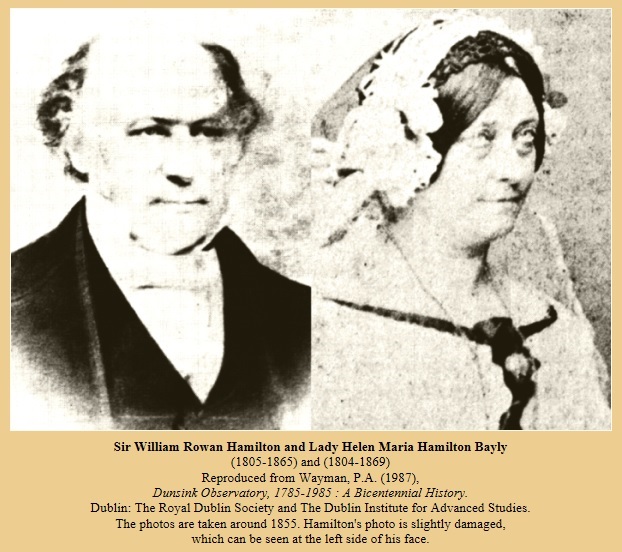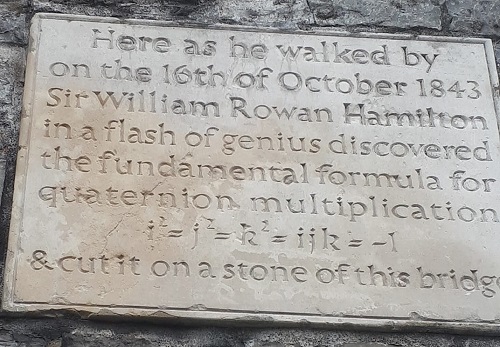] Life
| 1805-65; b. 4 Aug. 1805, 36 Lwr. Dominick St., Dublin; appt. Professor of Astronomy at Trinity College Dublin, and Astronomer Royal while still an undergraduate; contrib. to Dublin Literary Weekly; his inaugural lecture on astronomy at TCD, 8 Nov. 1832, was reprinted in the newly-founded Dublin University Review, Vol. 1 No. 1. (January 1833); fell in love with Catherine Disney, who entered a marriage with Rev. William Barlow [see under Jane Barlow, q.v.]; suffered from romantic disappointment and depression; later became enamoured of Ellen de Vere; m. Helen Maria Bayly, April 1833, also a love-match, residing together at the Dunsink Observatory; he was knighted in 1835 for his discovery of conical refraction; |
| elected honorary member of the Academy of St. Petersberg, and Astronomer Royal for Ireland; elected President of the RIA (1837-46) - in which capacity he secured the £1,000 govt. grant for the publication of O’Donovan’s translation of the Annals of the Four Masters (1848-51); he inscribed formula for quaternions on parapet of Broom [prop. Brougham; occas. Broome] Bridge on the Grand Canal while walking with his wife from Dunsink to the Royal Academy on Dawson St., 16 Oct. 1843 (‘an electric circuit seemed to close, and a spark flashed forth’); lectured on quaternions, 1843; issued Elements of Quaternions (1866) or an ‘algebra of pure space’; suffered a blow to his public reputation at the annual dinner of the Geological Society in the Customs House, 11 Feb. 1846, when overcome with dizziness on the stairs after dinner - and thus acquired a reputation for drunkenness; |
| d. 2 Sept. 1965, in Dublin; Charles Jasper Joly [q.v.] edited his Quaternions (1899-1901) and later published a Manual of Quaterions (1905); besides his mathematical attainments, Hamiulton was an acknowledged linguist and poet; there is a portrait by Thomas Kirk; Robert Perceval Graves biography of Hamilton (1882-89) erroneously implied that he suffered marital unhappiness and declined into drunkenness - a view corrected in later studies; Hamilton’s theory of Quaternions gives us the word ‘vectors’ meaning a quarternion of which a part is 0 [zero]; he was friendly with Aubrey Thomas de Vere [as infra]. CAB PI ODNB TAY DIB DIW DIH RAF OCEL OCIL |
| [ top ] |
|
||||||
| Note: Anne van Weerden (Univ. of Utrecht, NL) has written on the marriage of W. R. Hamilton correcting the widespread supposition that he was a drunkard in later life, as portrayed in the life by Robert Perceval Graves (1882-89). See ‘A most gossiped about genius: Sir William Rowan Hamilton’, in BSHM Bulletin: The Journal of the British Society for the History of Mathematics (12 Dec. 2017), pp.2-20 - available online. See also van Weerden’s full-length study, A Victorian Marriage: Sir William Rowan Hamilton (Stedum, NL: J Fransje van Weerden 2015; corr. edn. 2017) - available at Google Books online. |
|

|
See further - online; accessed 20.02.2018. |
[ top ]
Works
Numerous poems incl. in Robert Perceval P. Graves, The Life of Sir W. Rowan Hamilton: Professor of Astronomy in University of Dublin and Royal Astronomer of Ireland, incl. selection from his poems, corr., and miscell. writing (Dublin: Hodges Figgis 1882) [from which Mary Moorman quotes in her biography of Wordsworth]. His introductory lecture on Astronomy at TCD, held among the Madden Papers of the Gilbert Collection as MS 282 (Pearse St. Library, Dublin) was was printed in Dublin University Magazine (Jan. 1833).
|
||||||
|
[ top ]
|
[ top ]
Criticism
|
See also Anne van Weerden, Catherine Disney: A Biographical Sketch (J. Fransje van Weerden 2019), 145pp. [see note - infra] |
[ top ]
Commentary
Barbara Hayley, ‘Irish Periodicals’, in Anglo-Irish Studies, ii (1976) [pp.83-108], for remarks: ‘the Dublin University Review and Quarterly, which ran for a year from January 1833, an uncontentious magazine, contained William Rowan Hamilton’s sonnets, also imitations and translations of classical poetry, verses in Spanish, discussions of natural phenomena, continental books reviewed [&c.].’ (p.97.)
[ top ]
References
Dictionary of National Biography, competed as a child with Zerah Colburn, ‘the calculating boy’; at 16 detected error in Laplace’s Mechanique Céleste; double first at TCD; twice won Vice-Chancellor’s poetry prize; predicted ‘conical refraction’ while an undergraduate; appoint ed Andrews chair of Astronomy, 1827; astronomer royal of Ireland; gold medal, RSoc. for optical discovery, and for theory of general method of dynamics, 1834; knighted 1835; Pres. RIA, 1837; published Lectures on Quaternions (1853); Elements of Quarternions (1866), appeared posthumously.
Geoffrey Taylor, Irish Poets of the 19th c. (1951): Aubrey de Vere reported that Coleridge and Hamilton were the only men to whom Wordsworth would think of applying the term wonderful.
Margaret Drabble, Oxford Companion of English Literature (Oxford: OUP 1985), entry on Hamilton describes him as a mathematician and a friend of Wordsworth - who stayed with him at Dunsink in 1829 - Coleridge, Edgeworth and others.
Belfast Linenhall Library holds R. P. Graves, Life of Sir William Rowan Hamilton, 3 Vol. (1882-89).
[ top ]
Notes
A Portrait of William Rowan Hamilton by Thomas Kirk (see Anne Crookshank Irish Portraits [Exhibition Catalogue], Ulster Museum 1965). Note that Mary Moorman quotes from the life of Hamilton by Robert Perceval Graves (1882) in her biography of William Wordsworth.
|
Kith & Kin: William Rowan Hamilton [WRH] was a son of Archibald Hamilton (AH) and grandson of William Hamilton (WH), a Dublin apothecary. WH had married Grace MacFerrand, orig. from Galloway in Scotland, who had been adopted by Gawen Hamilton and Jane Rowan [Lady Jane Rowan Hamilton] of Killileagh Castle (or Killileigh; i.e., Killyleagh, Co. Down), thus becoming the sister of the United Irishman Archibald Hamilton Rowan (1750-1834; qv.). Hence Archibald Hamilton Rowan (AHR) was WRH’s paternal grand-uncle - and also his godfather. (Synopsis of remarks by Anne van Weerden on Hamilton’s second given name.) [For further on Killyleagh Castle, see under Archibald Hamilton Rowan - as infra.]
Thomas L. Hankins, William Hamilton Rowan (Johns Hopkins UP 2004): ‘One of the most imaginative mathematicians of the nineteenth century, Sir William Rowan Hamilton (1805-1865) changed the course of modern algebra with his discovery of quaternions in 1843. Although Hamilton’s work was largely theoretical, his ideas came to have invaluable practical applications with the advent of quantum mechanics in the twentieth century. In this acclaimed biography, Thomas L. Hankins brings together the many aspects of Hamilton’s life and work―from his significant contributions to mathematics, optics, and mechanics to his passion for metaphysics, poetry, and politics―fully portraying the brilliant man whose faith and idealism guided him in everything he did.’ (Amazon notice - online; accessed 20.02.2018).
Gameboy: The Icosian Game is a board game devised by Hamilton consisting of 20 numbered pieces in the shape of plugs which move on a round board configured in irradiating variable pentagons with plug-holes at each juncture. The game is held in the Royal Irish Academy, Dublin (RIA).
Catherine Disney: See Anne van Weerden, Catherine Disney: A Biographical Sketch (F. van Weerden 2019): ‘Catherine Disney (1800-1853) is known as the “lost love” of the Irish mathematician Sir William Rowan Hamilton (1805-1865), but about herself little is known. Based on what Hamilton wrote about her and scraps of information which were found on various places, extended with conclusions which could be drawn from known events, this is a sketch of how she fell in love with Hamilton in 1824, what the motives may have been for her family to force her to marry the reverend William Barlow (1792-1871), what may have triggered her suicide attempt in 1848 after which she did not live with Barlow any more, and how she spoke with Hamilton shortly before she died. In these two interviews she could finally tell Hamilton that she had also loved him. In the last chapters it is discussed how Catherine’s unhappiness seems to have influenced her eldest son, James Barlow (1826-1913), and through him also her granddaughter Jane Barlow (1856-1917). This sketch is supplementary to the essay A Victorian Marriage : Sir William Rowan Hamilton. But being self-contained, it can also be read on its own.’ (Available at Google Books - online,]

|
| —Catherine Disney: A Biographical Sketch (F. van Weerden 2019), pp.111, 18, 112, 29, & 57; available at Google Books - online. |
[ top ]
Dizzy times: Hamilton suffered a blow to his reputation at the annual dinner of the Geological Society in the Customs House, 11 Feb. 1846, when overcome with dizziness on the stairs having delivered his theory that Ireland ‘rose somewhat more out of the sea’ in summer than in winter, just then confirmed by astronomical observations at Markee - and thus acquired a reputation for drunkenness. the theory was communicated in the Journal of the Geological Society of Dublin, Vol. III, Pt. III, (1846), No. 2, edited by Robert Mallet, President of the Society - quoting Hamilton’s letter to him. There he writes: "the conversationin which I was engaged with you on this and similar subjects, at the last dinner of the Geological Society, interested and excited me at the time very much indeed; and if you think the forgoing memorandum, which I have drawn up at you desire, worthy of being incorporated in any communication of your own to the Society, it is perfectly at your service. / I remain, sir, very truly yours, / “William R. Hamilton”’. (Cited in Anne van Weerden, ‘A biographer’s opinion as primary source: the strange case of Sir William Rowan Hamilton’, given at the Maynooth Conference in the History of Mathematic (1&2 Aug. 2019). Van Weerden’s paper questions the truth of Graves’s persistent allegations of drunkenness against Hamilton and his related account of Hamilton’s unhappy marriage - for which she finds evidence to the contrary, if anything. (See online; accessed 20.10.2019.)
